2020高考英语作文范文:北京胡同
北京胡同的英语作文
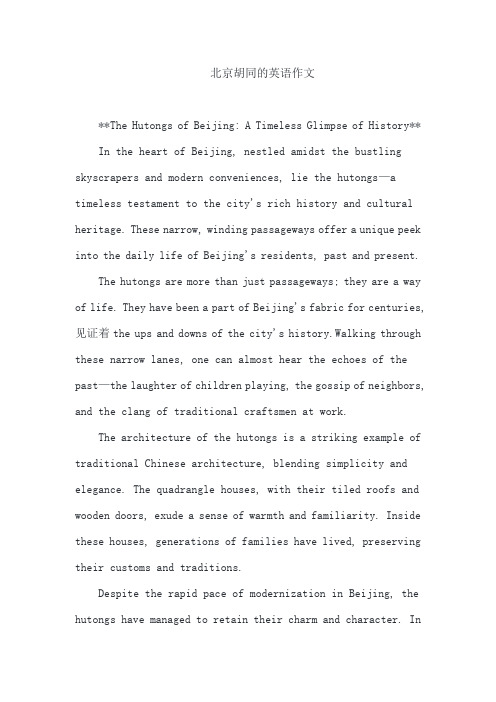
北京胡同的英语作文**The Hutongs of Beijing: A Timeless Glimpse of History** In the heart of Beijing, nestled amidst the bustling skyscrapers and modern conveniences, lie the hutongs—a timeless testament to the city's rich history and cultural heritage. These narrow, winding passageways offer a unique peek into the daily life of Beijing's residents, past and present.The hutongs are more than just passageways; they are a way of life. They have been a part of Beijing's fabric for centuries,见证着the ups and downs of the city's history.Walking through these narrow lanes, one can almost hear the echoes of the past—the laughter of children playing, the gossip of neighbors, and the clang of traditional craftsmen at work.The architecture of the hutongs is a striking example of traditional Chinese architecture, blending simplicity and elegance. The quadrangle houses, with their tiled roofs and wooden doors, exude a sense of warmth and familiarity. Inside these houses, generations of families have lived, preserving their customs and traditions.Despite the rapid pace of modernization in Beijing, the hutongs have managed to retain their charm and character. Inrecent years, there has been a renewed interest in preserving and restoring these historical lanes, ensuring that future generations can still experience the allure of old Beijing.Visiting the hutongs is not just about seeing the architecture or learning about history; it's about experiencing a way of life that is unique to Beijing. From the friendly faces of the locals to the scent of traditional food cooking, every detail offers a glimpse into the soul of the city.In conclusion, the hutongs of Beijing are not just a part of the city's historical landscape; they are an essential aspect of its cultural identity. They provide a window into the past, allowing us to connect with our heritage and appreciate the rich tapestry of Beijing's history.。
北京胡同作文英文

北京胡同作文英文英文:Beijing Hutongs。
Hutongs are narrow alleyways that are found in Beijing. They are a unique part of the city's history and culture. The word "hutong" comes from the Mongolian language and means "water well". This is because many of the hutongs were built around a central water source.Hutongs are usually lined with traditional courtyard houses, known as "siheyuan". These houses have a central courtyard that is surrounded by rooms. The courtyard is often used for socializing and as a place for children to play. Many of the siheyuan have been converted into boutique hotels, restaurants, and shops.One of the things I love about hutongs is the sense of community. People who live in the hutongs often know theirneighbors and are very friendly. It's not uncommon to see people sitting outside their homes, chatting with each other or playing games.Another thing I enjoy about the hutongs is the street food. There are many small vendors selling all kinds of snacks and dishes. One of my favorites is jianbing, a kind of Chinese crepe that is filled with egg, vegetables, and sauce.Overall, the hutongs are a must-visit for anyone traveling to Beijing. They offer a glimpse into the city's past and present, and are a great place to experience the local culture.中文:北京胡同。
北京胡同的英语作文

北京胡同的魅力Beijing Hutong: A Charming Embodiment of Ancient CultureAmidst the bustling metropolis of Beijing, the hutong, a unique architectural style, stands as a silent witness to the city's rich history and profound culture. These narrow alleys, interwoven with ancient quadrangle courtyards, exude a captivating charm that captivates both locals and foreigners alike.Hutong, a term derived from the Mongolian word for "water well," originally referred to the alleyways surrounding the wells. Over time, they evolved into the distinctive maze of narrow lanes and courtyards that characterize Beijing's urban landscape. These alleyways, often lined with traditional brick-and-wood houses, offer a glimpse into the daily lives of ordinary Beijing residents, revealing a side of the city that is often overlooked by tourists.Walking through the hutong, one can almost hear the echoes of history whispering through the centuries. Theuneven cobblestone pavement, the fading murals on the walls, and the occasional bicycle bell ringing in the distance all contribute to the atmosphere of timelessness. Here, thefast pace of modern life seems to have been left behind, replaced by a serene and relaxed atmosphere.The hutong are not just architectural relics; they are also repositories of Beijing's cultural traditions. Many of these alleyways are named after notable figures fromhistory or after significant events, providing a glimpseinto the city's rich heritage. Furthermore, the hutong are closely linked to Beijing's culinary culture, with numerous small restaurants and food stalls offering traditional Beijing cuisine such as dumplings, bean curd, and roast duck.Despite the inevitable impact of urbanization and modernization, efforts have been made to preserve andrestore the hutong. Many of them have been transformed into cultural and artistic spaces, attracting artists, writers, and tourists alike. These renovated hutong offer a unique blend of traditional and modern elements, providing a platform for cultural exchange and innovation.The charm of the hutong lies not only in their physical beauty but also in the warmth and familiarity they evoke. They are a symbol of Beijing's resilience and adaptability, demonstrating how the city has managed to balance its ancient traditions with the demands of modern life. As such, the hutong are not just a tourist attraction; they are an integral part of Beijing's identity and culture.In conclusion, the hutong of Beijing are a testament to the city's rich history and vibrant culture. They offer a unique perspective on Beijing's past and present, providing a window into the lives of its residents and a glimpse into its soul. Whether you are a local or a visitor, a stroll through the hutong is sure to leave a lasting impression on your heart and mind.**北京胡同的魅力**在繁华喧嚣的北京城中,胡同作为一种独特的建筑风格,静静地见证着这座城市丰富的历史和深厚的文化。
向外国人介绍北京胡同的英语作文
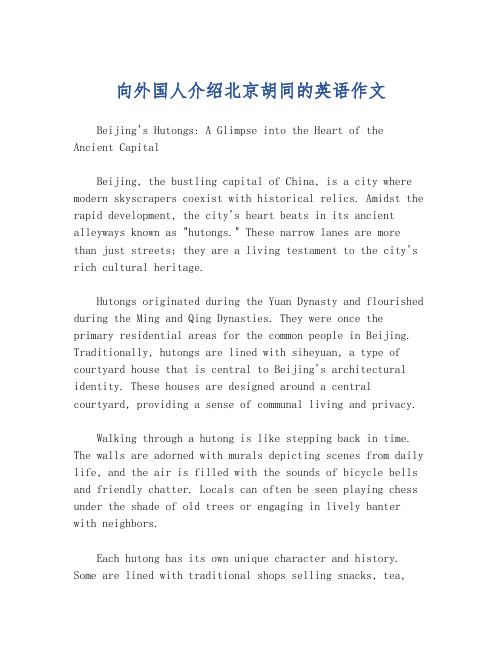
向外国人介绍北京胡同的英语作文Beijing's Hutongs: A Glimpse into the Heart of the Ancient CapitalBeijing, the bustling capital of China, is a city where modern skyscrapers coexist with historical relics. Amidst the rapid development, the city's heart beats in its ancient alleyways known as "hutongs." These narrow lanes are more than just streets; they are a living testament to the city's rich cultural heritage.Hutongs originated during the Yuan Dynasty and flourished during the Ming and Qing Dynasties. They were once the primary residential areas for the common people in Beijing. Traditionally, hutongs are lined with siheyuan, a type of courtyard house that is central to Beijing's architectural identity. These houses are designed around a central courtyard, providing a sense of communal living and privacy.Walking through a hutong is like stepping back in time. The walls are adorned with murals depicting scenes from daily life, and the air is filled with the sounds of bicycle bells and friendly chatter. Locals can often be seen playing chess under the shade of old trees or engaging in lively banter with neighbors.Each hutong has its own unique character and history. Some are lined with traditional shops selling snacks, tea,and handicrafts, while others are home to small art galleries and cafes. The alleyways are a labyrinth of stories waiting to be discovered, from the tales of emperors and scholars to the everyday lives of the people who have called these lanes home for generations.Despite the encroachment of modernity, efforts are being made to preserve and revitalize the hutongs. Many have been transformed into cultural spaces, where visitors can experience traditional Beijing life, sample local cuisine, and participate in workshops on crafts such as paper-cutting and calligraphy.In conclusion, the hutongs of Beijing are more than just a part of the city's infrastructure; they are the soul of Beijing. They offer a window into the past and a connection to the traditions that continue to shape the city's identity. For anyone seeking to understand the true essence of Beijing, a visit to its hutongs is an experience not to be missed.。
北京胡同介绍作文英文
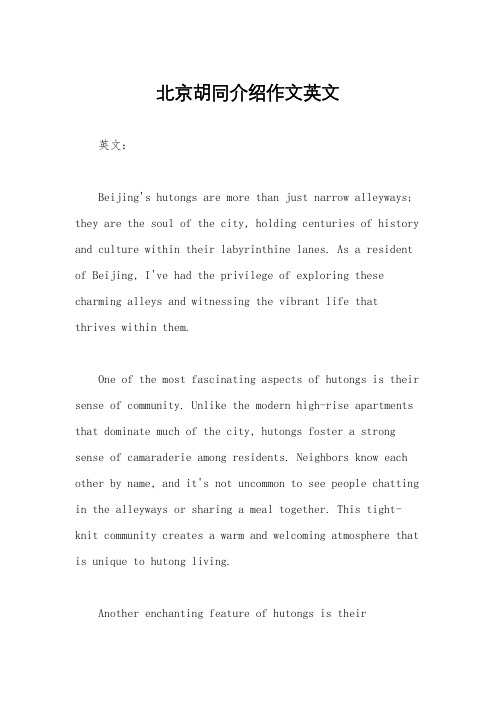
北京胡同介绍作文英文英文:Beijing's hutongs are more than just narrow alleyways; they are the soul of the city, holding centuries of history and culture within their labyrinthine lanes. As a resident of Beijing, I've had the privilege of exploring these charming alleys and witnessing the vibrant life thatthrives within them.One of the most fascinating aspects of hutongs is their sense of community. Unlike the modern high-rise apartments that dominate much of the city, hutongs foster a strong sense of camaraderie among residents. Neighbors know each other by name, and it's not uncommon to see people chatting in the alleyways or sharing a meal together. This tight-knit community creates a warm and welcoming atmosphere that is unique to hutong living.Another enchanting feature of hutongs is theirarchitectural beauty. Many of these alleyways are lined with traditional courtyard homes, known as siheyuans, which date back to imperial China. These elegant structures feature intricately carved wooden doors, sloping tiled roofs, and serene inner courtyards. Walking through the hutongs feels like stepping back in time, as the architecture remains largely unchanged despite the rapid modernization happening around them.Moreover, hutongs are culinary havens, offering a plethora of delicious street food and hole-in-the-wall eateries. Whether you're craving spicy lamb skewers, steaming bowls of noodles, or crispy jianbing (Chinese crepes), you'll find it all in the bustling alleyway markets. These culinary delights are not only a feast for the taste buds but also a window into Beijing's diverse food culture.In addition to their cultural significance, hutongs also play a vital role in preserving Beijing's heritage. As the city continues to develop and expand, many historic neighborhoods have been demolished to make way for newconstruction. However, efforts are underway to protect and restore the remaining hutongs, ensuring that future generations can appreciate their beauty and charm.中文:北京的胡同不仅仅是狭窄的小巷道;它们是这座城市的灵魂,在其迷宫般的巷道中蕴藏着几个世纪的历史和文化。
向美国人介绍北京胡同的英语作文

向美国人介绍北京胡同的英语作文全文共6篇示例,供读者参考篇1Exploring Beijing HutongsHi there! My name is Lily, and I want to tell you all about Beijing Hutongs. Hutongs are narrow, traditional alleys in Beijing, the capital city of China. They are like a maze, with lots of twists and turns, and they are super fun to explore!Beijing Hutongs are really old, some of them are more than 700 years old! That's even older than my grandparents! They have a special charm and are a window into the history and culture of Beijing. When you walk through the Hutongs, you can see traditional courtyard houses called Siheyuan. They have beautiful red gates and gray bricks, and they look so cool!One of the best things about Hutongs is that they are full of life. You can see people playing games, riding their bikes, and even flying kites! It's like a big playground for everyone. You can also find small shops and local restaurants in the Hutongs. They sell yummy street food like Beijing pancakes and sugar-coated haws. They are so tasty!I love exploring the Hutongs with my friends. Sometimes we rent bicycles and ride through the narrow alleys. It feels like an adventure! We also like to visit the Drum Tower and the Bell Tower, which are famous landmarks in Beijing. From the top, you can see the whole city and all the Hutongs stretching out like a spiderweb. It's really amazing!In the Hutongs, you can also find traditional Chinese arts and crafts. I once visited a place where they make beautifulhand-painted fans. The artists were so talented! They showed us how to paint our own fans, and I made one with pretty flowers and birds. It's now hanging in my room, reminding me of the fun time I had in the Hutongs.Beijing Hutongs are not only fun, but they are also important for preserving the history and culture of China. It's like stepping back in time and seeing how people lived long ago. Some Hutongs have been turned into museums, where you can learn about traditional Chinese customs and traditions. It's like going on a time-travel adventure!If you ever visit Beijing, don't forget to explore the Hutongs. They are a hidden treasure waiting to be discovered. You can learn so much and have a great time. Just remember to bringyour sense of adventure and curiosity. Who knows what surprises you may find around the next corner!So, that's all about Beijing Hutongs! I hope you enjoyed learning about them. Maybe one day, you can come and visit me, and we can explore the Hutongs together. It will be so much fun! See you soon!Love,LilyWord Count: 376 words篇2Exploring Beijing's HutongsHi there, everyone! Today, I want to tell you all about a special part of Beijing called the "Hutongs." I think you'll find them really interesting!Beijing is the capital city of China, and it has a lot of big buildings and busy streets. But hidden among all the tall buildings, there are these narrow lanes called Hutongs. They are like a maze of small streets that connect houses and neighborhoods.The word "Hutong" actually means "lane" in Chinese. These lanes are very old and have a lot of history. They have been around for hundreds of years and have seen many changes in Beijing.When you walk through the Hutongs, it feels like you are stepping back in time. You can see traditional Chinese houses called "Siheyuan" along the lanes. Siheyuan houses have a courtyard in the center, and the rooms are built around it. It's really cool to see how people used to live in old Beijing.There are many things to do and see in the Hutongs. One of my favorite things is to ride in a "rickshaw." It's like a small cart pulled by a bicycle. The rickshaw drivers take you on a tour of the Hutongs, and you can see all the interesting sights along the way. It's so much fun!You can also find lots of little shops and markets in the Hutongs. They sell all kinds of things like traditional crafts, clothes, and delicious street food. Don't forget to try some Beijing snacks like "jianbing" (a kind of pancake) or "baozi" (steamed buns). They are really yummy!Another thing that makes the Hutongs special is the sense of community. People in the Hutongs are very friendly and theyhelp each other. You might see neighbors chatting with each other or kids playing games together. It's like a big family!In recent years, the government has been working to preserve the Hutongs because they are an important part of Beijing's history and culture. They are also becoming popular with tourists from all over the world. So, if you ever visit Beijing, make sure to explore the Hutongs. You won't be disappointed!I hope you enjoyed learning about the Beijing Hutongs. They are a unique and wonderful place. Maybe one day, you can come and visit them for yourself. See you soon!Word count: 274 words篇3Exploring Beijing HutongsHi everyone! Today I want to tell you all about the amazing Beijing Hutongs. Hutongs are narrow streets or alleys that can be found in Beijing, the capital city of China. They are filled with history, culture, and lots of exciting things to see and do.Beijing Hutongs have been around for hundreds of years and they are an important part of the city's heritage. These traditional alleyways are made up of small, old-fashioned housescalled siheyuans. Siheyuans are courtyard homes with rooms surrounding a central courtyard. They are very different from the big skyscrapers and modern buildings you might see in other parts of Beijing.One of the best things about the Hutongs is that they are full of life and activity. As you walk through the narrow streets, you can see local residents going about their daily lives. You might see people playing traditional Chinese musical instruments, practicing Tai Chi, or even flying kites in the open spaces. It's like stepping back in time!Exploring the Hutongs is like going on an adventure. You can wander through the maze-like streets and discover hidden treasures along the way. There are small shops selling all sorts of interesting things, like handmade crafts, traditional clothes, and delicious street food. Don't forget to try some local snacks like Beijing-style fried dough twists or candied haws on a stick – they are absolutely delicious!One of the most famous Hutongs in Beijing is called Nanluoguxiang. It's a bustling street lined with shops, restaurants, and teahouses. It's a great place to shop for souvenirs, taste local delicacies, or just take a leisurely stroll. You can also rent a traditional rickshaw and have a fun ride aroundthe area. The rickshaw drivers can tell you all about the history and stories behind the Hutongs.If you're feeling adventurous, you can even visit the Drum Tower and Bell Tower, which are located near the Hutongs. These ancient towers were used to mark the time and make important announcements in the past. You can climb to the top of the towers and enjoy a panoramic view of the city. It's a great way to see just how vast and beautiful Beijing is.In conclusion, Beijing Hutongs are a unique and fascinating part of the city. They offer a glimpse into the rich history and culture of China. So, if you ever have the chance to visit Beijing, make sure to explore the Hutongs. You'll be amazed by the sights, sounds, and flavors that await you in these charming alleyways. Have a great adventure!Word Count: 351 wordsI hope you find this essay helpful and informative! If you have any more questions or need further assistance, feel free to ask.篇4Exploring Beijing HutongsHi everyone! Today, I want to tell you all about a fascinating place in Beijing called "Hutongs." Hutongs are narrow streets or alleys with traditional courtyard houses on both sides. They are like a maze of history and culture right in the heart of the city!In Beijing, Hutongs have a long history that can be traced back to hundreds of years ago. They were originally built during the Yuan, Ming, and Qing dynasties. Hutongs are unique to Beijing and have become an important part of its cultural heritage.When you walk through a Hutong, you'll feel like you've traveled back in time. The old gray-brick houses with black-tiled roofs give you a glimpse of ancient China. Some of these houses have been turned into museums, tea houses, or shops that sell traditional handicrafts, allowing us to experience the traditional way of life.One of the most exciting things about Hutongs is exploring the different activities happening there. You can see people playing Chinese chess, practicing Tai Chi, or flying kites. It's a lively and vibrant place where you can learn about Chinese traditions and customs.Another interesting aspect of Hutongs is the delicious food you can find there. Many small restaurants and food stalls offermouth-watering local dishes. You can try Beijing's famous "Jianbing," a savory pancake filled with eggs, vegetables, and sauce. Don't forget to taste the "Douzhir" as well, a traditional fermented drink that is both sweet and sour.Getting around in Hutongs is also an adventure. Since the streets are narrow, you can ride a rickshaw, which is a traditional Chinese vehicle pulled by a bicycle. It's a fun and unique way to explore the area and learn about its history from the rickshaw driver.In addition to the cultural significance, Hutongs are also an important part of Beijing's urban life. They provide a sense of community and closeness among the residents. People living in Hutongs often know each other well and have a strong bond, creating a warm and friendly atmosphere.However, Hutongs face challenges due to modernization and urban development. Many Hutongs have been demolished to make way for new buildings and roads. Fortunately, efforts are being made to preserve and protect the remaining Hutongs, recognizing their historical and cultural value.In conclusion, Hutongs are a treasure trove of history, culture, and traditions in Beijing. They offer a unique glimpse into the past and provide a wonderful opportunity for us to learnabout Chinese customs. So, if you ever visit Beijing, don't forget to explore the Hutongs and immerse yourself in their charm and beauty!I hope you enjoyed learning about Beijing Hutongs. Thank you for reading my essay!篇5Exploring Beijing HutongsHi there! Today, I want to tell you all about the fascinating Beijing Hutongs. My name is Lily, and I'm a primary school student from China. Let's take a journey together and discover the magic of these ancient alleyways!Beijing Hutongs are narrow streets or alleys that have been around for hundreds of years. They are like a maze, forming a unique part of Beijing's history and culture. The word "Hutong" comes from the Mongolian word "hottog," meaning "water well." In the past, Beijing had many water wells, and the surrounding neighborhoods were called Hutongs.I live in Beijing, and I love exploring the Hutongs with my friends and family. They are full of surprises and stories. As you walk through the Hutongs, you can see traditional courtyardhouses called "Siheyuan." These houses have a square or rectangular shape with rooms surrounding a courtyard in the center. It's like a little village inside a city!The Hutongs are not just houses; they are also a vibrant community. People live, work, and play here. You can see families sitting outside, chatting and playing games. Sometimes, you might even spot people practicing Tai Chi or playing traditional instruments. It's so cool to see how people live their everyday lives in the Hutongs.One of my favorite things about the Hutongs is the food. There are so many delicious treats to try! You can find street vendors selling yummy snacks like Beijing-style fried dough twists, candied hawthorns, and jianbing, a tasty Chinese pancake. The aroma of these foods fills the air, and it's impossible to resist their tempting flavors.As you explore deeper into the Hutongs, you might come across historic landmarks. One famous landmark is the Drum Tower. It's a tall and ancient building where drums were beaten in the past to announce the time. If you climb up to the top, you'll get a breathtaking view of the Hutongs and the city skyline.Another exciting place to visit is the Prince Gong's Mansion. It's a grand mansion with beautiful gardens and traditional architecture. You can learn about the life of the royal family and imagine what it was like to live in such a magnificent place.The Hutongs have a rich history that you can feel as you walk through them. Some Hutongs have been around for over 800 years! They witnessed the rise and fall of dynasties, the bustling trade of ancient times, and the changes that modernization brought to Beijing. It's like stepping back in time.Sadly, many Hutongs have been demolished to make way for modern buildings. But the good news is that efforts are being made to preserve and protect these precious cultural treasures. People are realizing the importance of the Hutongs and their contribution to Beijing's identity.Visiting the Beijing Hutongs is like entering a time machine. You can experience the old and the new, the traditional and the modern, all in one place. It's a journey that will leave you with unforgettable memories and a deeper understanding of Chinese history and culture.So, if you ever come to Beijing, don't forget to explore the Hutongs. They are waiting to share their secrets with you. Come and discover the wonders of Beijing's ancient alleyways!I hope you enjoyed learning about the Beijing Hutongs through my eyes. Thank you for joining me on this adventure!篇6Exploring Beijing HutongsHello everyone! Today, I want to tell you all about an amazing place in Beijing called "Hutongs." Hutongs are special neighborhoods in Beijing that have a lot of history and unique charm. Let's explore them together!First of all, what is a Hutong? Well, a Hutong is a type of narrow street or alleyway that is surrounded by traditional courtyard houses called "Siheyuan." These houses have beautiful red walls and gray-tiled roofs. Hutongs are like mazes with winding paths, and they are really fun to explore!Beijing has a long history, and Hutongs are a big part of that history. Some of these Hutongs are more than 800 years old! They were built during the time of the Yuan, Ming, and Qing dynasties. Walking through the Hutongs is like stepping back in time and experiencing ancient Beijing.One of the best things about Hutongs is the sense of community. People living in Hutongs are very friendly andwelcoming. You can often see neighbors chatting with each other in the courtyards or playing traditional games like Mahjong. The atmosphere is cozy and warm.There are many interesting things to see and do in the Hutongs. One of my favorite activities is riding a "Pedicab" or "Rickshaw" through the narrow streets. The drivers pedal the bicycles while you sit back and enjoy the ride. It's so much fun!You can also visit local shops and restaurants in the Hutongs. They sell all kinds of traditional Chinese handicrafts, likepaper-cuttings, clay figurines, and silk products. Don't forget to try some delicious Beijing snacks too, like "Zhajiangmian" (noodles with soybean paste) or "Baozi" (steamed stuffed buns).If you're interested in history, there are some famous Hutongs that you should visit. One of them is called "Nanluoguxiang." It's a bustling Hutong with lots of shops, cafes, and art galleries. Another popular one is "Yandaixiejie," famous for its antique stores and teahouses.In the winter, the Hutongs become even more magical. The roofs and streets get covered in a blanket of snow, and it looks like a fairytale land. People gather in courtyards to make dumplings and celebrate the Chinese New Year. It's a joyful and festive time!To sum up, Beijing Hutongs are a treasure trove of history, culture, and fun. They give you a glimpse into the traditional way of life in Beijing and allow you to experience the warmth of Chinese hospitality. So, if you ever visit Beijing, don't forget to explore the Hutongs and immerse yourself in their beauty and charm.I hope you enjoyed learning about Beijing Hutongs! Thank you for reading my essay.。
旅游北京胡同英语作文

旅游北京胡同英语作文Beijing, the capital of China, is a city rich in history and culture. One of the most fascinating aspects of Beijing is its hutongs, narrow alleyways that reflect the traditional lifestyle of its residents. These hutongs are not just streets; they are the heart and soul of the city, showcasing the charm of old Beijing.When I visit the hutongs, I often feel like I have stepped back in time. The courtyard houses, known as siheyuan, line the streets, each with its unique architecture and history. Walking through these alleys, I see old men playing chess, children flying kites, and families gathering for meals. The atmosphere is lively and warm, filled with the sounds of laughter and conversation.One of my favorite hutongs is Nanluoguxiang. This area is famous for its trendy shops, cafes, and street food vendors. I love trying local snacks like jiaozi (dumplings) and jianbing (Chinese crepes) while exploring the unique boutiques. The mix of traditional and modern elements makes Nanluoguxiang a perfect placefor both locals and tourists.Another notable hutong is Yandaixiejie, known for its history and culture. It is one of the oldest hutongs in Beijing, and walking through it feels like walking through a living museum. Many shops here sell traditional crafts, such as handmade paper cuts and silk products, allowing visitors to experience the rich cultural heritage of the city.In conclusion, exploring the hutongs of Beijing is an unforgettable experience. They offer a glimpse into the past while showcasing the vibrant life of the present. I always leave feeling inspired and connected to the rich history of this amazing city.中文翻译:北京是中国的首都,拥有丰富的历史和文化。
介关于北京胡同英语作文
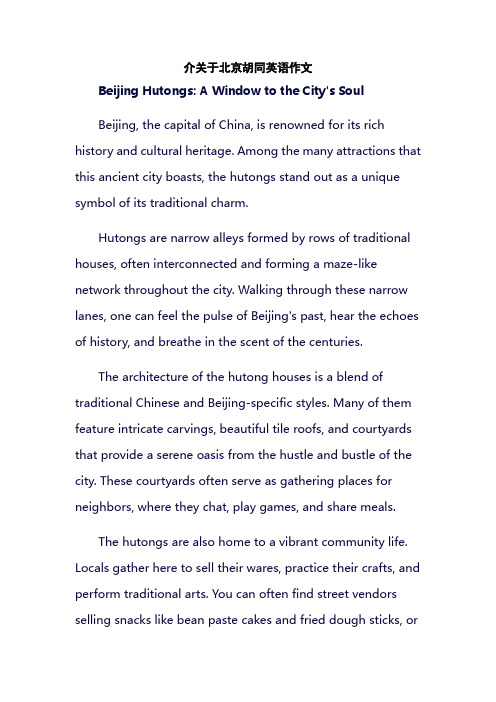
介关于北京胡同英语作文Beijing Hutongs: A Window to the City's SoulBeijing, the capital of China, is renowned for its rich history and cultural heritage. Among the many attractions that this ancient city boasts, the hutongs stand out as a unique symbol of its traditional charm.Hutongs are narrow alleys formed by rows of traditional houses, often interconnected and forming a maze-like network throughout the city. Walking through these narrow lanes, one can feel the pulse of Beijing's past, hear the echoes of history, and breathe in the scent of the centuries.The architecture of the hutong houses is a blend of traditional Chinese and Beijing-specific styles. Many of them feature intricate carvings, beautiful tile roofs, and courtyards that provide a serene oasis from the hustle and bustle of the city. These courtyards often serve as gathering places for neighbors, where they chat, play games, and share meals.The hutongs are also home to a vibrant community life. Locals gather here to sell their wares, practice their crafts, and perform traditional arts. You can often find street vendors selling snacks like bean paste cakes and fried dough sticks, orhear the sounds of traditional instruments and singing drifting from a nearby courtyard.Moreover, the hutongs offer a glimpse into Beijing's changing landscape. As the city continues to expand and modernize, some hutongs are disappearing, but many have been preserved and restored as cultural heritage sites. These preserved hutongs have become popular tourist attractions, attracting visitors from all over the world who want to experience the authentic Beijing lifestyle.In conclusion, the hutongs of Beijing are not just narrow alleys; they are a window to the city's soul, a bridge between the past and the present, and a testament to the enduring charm of traditional Chinese culture.。
北京胡同英语作文60词
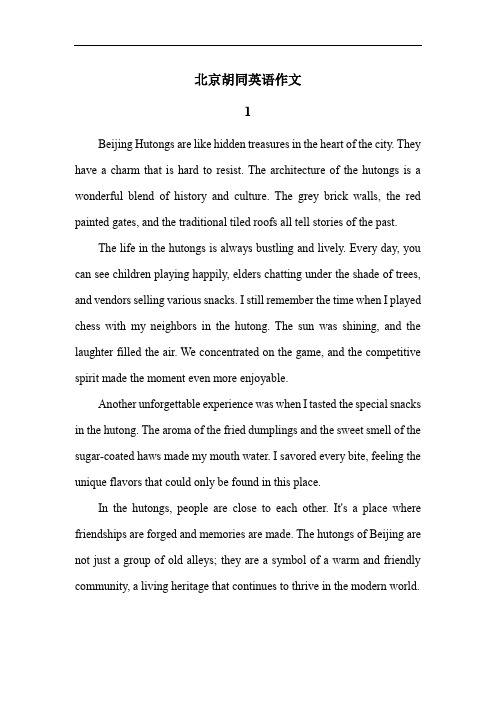
北京胡同英语作文1Beijing Hutongs are like hidden treasures in the heart of the city. They have a charm that is hard to resist. The architecture of the hutongs is a wonderful blend of history and culture. The grey brick walls, the red painted gates, and the traditional tiled roofs all tell stories of the past.The life in the hutongs is always bustling and lively. Every day, you can see children playing happily, elders chatting under the shade of trees, and vendors selling various snacks. I still remember the time when I played chess with my neighbors in the hutong. The sun was shining, and the laughter filled the air. We concentrated on the game, and the competitive spirit made the moment even more enjoyable.Another unforgettable experience was when I tasted the special snacks in the hutong. The aroma of the fried dumplings and the sweet smell of the sugar-coated haws made my mouth water. I savored every bite, feeling the unique flavors that could only be found in this place.In the hutongs, people are close to each other. It's a place where friendships are forged and memories are made. The hutongs of Beijing are not just a group of old alleys; they are a symbol of a warm and friendly community, a living heritage that continues to thrive in the modern world.2I grew up in a Beijing hutong, and those days were the most precious memories of my life. The hutong was like a big family, where everyone knew each other and shared joys and sorrows.When I was a child, the hutong was my playground. I spent countless afternoons playing hide-and-seek with my little friends. We would run around, laughing and shouting, hiding in every corner of the narrow alleys. Sometimes, I would hide behind the big old tree at the entrance of the hutong, and my heart would beat fast as I waited to be found. Those moments of excitement and anticipation are still vivid in my mind.In the summer evenings, the adults would sit outside their houses, chatting and fanning themselves to drive away the heat. We children would lie on the cool ground, looking up at the stars and imagining all kinds of wonderful things. The gentle breeze blew through the hutong, carrying the fragrance of flowers and the sounds of people's laughter.The hutong was also a place full of warmth and care. When I was sick, the neighbors would come to visit and bring me delicious food. When I had difficulties, they would offer their help and support without hesitation.As I grew older, the hutong gradually changed. Some old houses were demolished, and new buildings rose up. But no matter how it changes, the deep feelings I have for this place will never fade. The hutong is not just a place, but a part of my soul. It is where my childhood dreams were bornand where my most precious memories lie.3Beijing's Hutongs are like living history books, each season painting a distinct and charming picture.In spring, the Hutongs come alive with colors. Blossoms of various kinds burst forth along the narrow alleys, as if nature is holding a grand flower show. The gentle breeze carries the sweet fragrance, and petals flutter down like pink and white snowflakes. The old brick walls are adorned with the tender green of climbing vines, creating a refreshing sight.Summer brings a different charm. The sunlight filters through the dense foliage, casting dappled shadows on the ground. The sounds of cicadas fill the air, adding a lively rhythm to the otherwise peaceful scene. Residents sit outside their doors, enjoying the coolness and chatting with neighbors, their laughter echoing through the Hutongs.Autumn is a season of golden hues. The leaves turn yellow and red, creating a beautiful carpet on the ground. As you walk through the Hutongs, the rustling of fallen leaves under your feet is like a soft melody. The autumn wind carries a slight chill, but it also brings a sense of tranquility and serenity.Winter covers the Hutongs with a white blanket of snow. The rooftops and walls are dusted with snow, and icicles hang from the eaves like crystal daggers. The cold air makes your breath visible, but it also makes thewarmth of the houses and the kindness of the people inside more inviting.The beauty of Beijing's Hutongs throughout the seasons is a source of endless inspiration and a testament to the passage of time. It is a place where tradition and nature blend seamlessly, creating a haven of peace and beauty in the midst of a bustling city.4One sunny weekend, I decided to explore the alleys of Beijing. As I wandered along the narrow, winding paths, I was completely immersed in the unique charm of the old city.Suddenly, in a quiet corner of the alley, I came across an elderly man. He was sitting in front of his small workshop, surrounded by various tools and materials. Intrigued, I approached him and discovered that he was a master of traditional handicrafts.The old man's hands moved deftly, shaping and carving a piece of wood with precision and care. His eyes were focused and full of passion, as if the entire world existed only in his hands and the work before him. I stood there, mesmerized, watching him transform a simple piece of wood into a beautiful work of art.He noticed my interest and began to tell me stories about his craft, sharing the history and techniques passed down through generations. His words were like a key, unlocking a door to a world I had never known before.That encounter in the Beijing alley left a deep impression on me. It made me realize that behind every traditional handicraft lies not only exquisite skills but also the spirit of persistence and dedication. It was a moment that I will cherish forever, a precious memory in the heart of this ancient city.5Beijing Hutongs, the narrow alleys that crisscross the ancient parts of the city, hold within them a wealth of history and culture. They originated centuries ago and have witnessed the rise and fall of dynasties, the ebb and flow of people's lives.The development of Beijing Hutongs is a fascinating story. They were initially designed to accommodate the living needs of the common folk, providing a close-knit community where neighbors knew each other well. Over time, they became more than just a place to live; they became a symbol of traditional Chinese architecture and social structure.The architecture of the hutongs is a masterpiece of simplicity and functionality. The grey brick walls, the red-painted doors, and the tiled roofs all tell tales of the past. The layout of the hutongs, with their interconnecting paths and small courtyards, reflects a sense of order and harmony.In these hutongs, one can still feel the echoes of history. The traditional way of life, the local customs, and the folk art passed down fromgeneration to generation all contribute to the unique charm of the place. It is a living museum, where the past and the present coexist.However, with the rapid modernization of the city, many hutongs face the threat of demolition. It is our responsibility to protect and preserve these precious cultural heritages so that future generations can also experience the beauty and wisdom of the past.。
写北京胡同英语作文
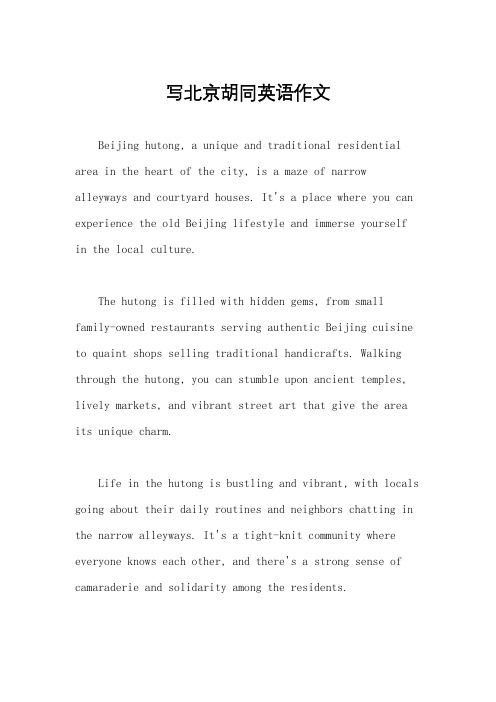
写北京胡同英语作文Beijing hutong, a unique and traditional residential area in the heart of the city, is a maze of narrow alleyways and courtyard houses. It's a place where you can experience the old Beijing lifestyle and immerse yourselfin the local culture.The hutong is filled with hidden gems, from small family-owned restaurants serving authentic Beijing cuisine to quaint shops selling traditional handicrafts. Walking through the hutong, you can stumble upon ancient temples, lively markets, and vibrant street art that give the area its unique charm.Life in the hutong is bustling and vibrant, with locals going about their daily routines and neighbors chatting in the narrow alleyways. It's a tight-knit community where everyone knows each other, and there's a strong sense of camaraderie and solidarity among the residents.Despite its traditional charm, the hutong is also evolving with the times. Many old courtyard houses havebeen renovated into modern homes, and trendy cafes and boutique hotels are popping up in the area. It's a fascinating blend of old and new, where ancient traditions coexist with modern influences.Exploring the hutong is like taking a step back in time, as you wander through the labyrinth of alleyways and discover the rich history and culture of Beijing. It's a place where you can truly experience the authentic essenceof the city and create lasting memories.。
介关于北京胡同英语作文
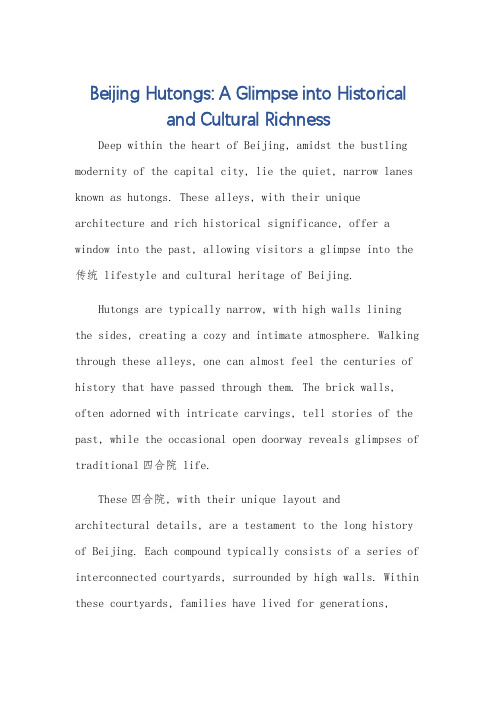
Beijing Hutongs: A Glimpse into Historicaland Cultural RichnessDeep within the heart of Beijing, amidst the bustling modernity of the capital city, lie the quiet, narrow lanes known as hutongs. These alleys, with their unique architecture and rich historical significance, offer a window into the past, allowing visitors a glimpse into the 传统 lifestyle and cultural heritage of Beijing.Hutongs are typically narrow, with high walls lining the sides, creating a cozy and intimate atmosphere. Walking through these alleys, one can almost feel the centuries of history that have passed through them. The brick walls, often adorned with intricate carvings, tell stories of the past, while the occasional open doorway reveals glimpses of traditional四合院 life.These四合院, with their unique layout andarchitectural details, are a testament to the long history of Beijing. Each compound typically consists of a series of interconnected courtyards, surrounded by high walls. Within these courtyards, families have lived for generations,maintaining the traditional way of life despite the changing times.The hustle and bustle of modern Beijing is just astone's throw away from these serene hutongs. Yet, within these lanes, time seems to have stood still. The residents of the hutongs, many of whom are descendants of theoriginal families who settled here centuries ago, maintain the traditional way of life, with respect for their ancestors and their culture.One of the most charming aspects of the hutongs is the friendly and welcoming atmosphere. Residents often greet each other with warm smiles and friendly hellos, creating a sense of community that is increasingly rare in modern cities. This sense of community is further enhanced by the various activities that take place in the hutongs, such as neighbors chatting over a game of chess or children playing in the streets.Despite their charm and historical significance, the hutongs of Beijing are facing many challenges today. With the rapid pace of urbanization and modernization, many of these lanes are being replaced by modern high-rises andshopping malls. However, efforts are being made to preserve and protect these historical treasures, ensuring thatfuture generations can still experience the unique charmand history of Beijing's hutongs.In conclusion, the hutongs of Beijing offer a uniqueand fascinating glimpse into the historical and cultural richness of this ancient city. They are not just physical spaces but also repositories of memories and traditionsthat have been passed down through generations. Visiting these lanes is not just a trip back in time but also an opportunity to connect with the spirit and soul of Beijing. **北京胡同:历史与文化的缩影**在北京的心脏地带,在这座繁忙的首都城市的深处,隐藏着狭窄的小巷,被称为胡同。
北京胡同特色英文介绍作文

北京胡同特色英文介绍作文英文:Beijing's hutongs are a unique feature of the city, and they are a must-see for anyone visiting the capital of China. Hutongs are narrow alleys or lanes, typically found in the old part of the city, and they are a significant part of Beijing's cultural heritage.I remember the first time I wandered through the hutongs, I was immediately struck by the charm and character of these traditional neighborhoods. The architecture is a beautiful mix of traditional Chinese courtyard homes and modern buildings, and the narrowstreets are lined with small shops, tea houses, and local eateries. It's a vibrant and bustling community, and it offers a fascinating glimpse into the daily lives ofBeijing's residents.One of the things that I love most about the hutongs isthe sense of history and tradition that you can feel as you walk through them. Many of the hutongs have been around for centuries, and they are filled with stories and memories of generations past. It's a living, breathing museum ofBeijing's past, and it's a privilege to be able to experience it firsthand.Another aspect of the hutongs that I find particularly charming is the strong sense of community that existswithin them. People in the hutongs know each other, and there's a real sense of camaraderie and togetherness. It's not uncommon to see neighbors chatting in the streets, children playing together, and elderly residents sitting outside their homes, enjoying the sunshine and each other's company. It's a tight-knit community, and it's heartwarming to witness.In addition to the sense of history and community, the hutongs are also home to some of the best food in Beijing. There are countless hidden gem restaurants tucked away in the alleyways, serving up delicious and authentic Chinese cuisine. From steaming bowls of noodles to mouthwateringdumplings, the hutongs are a food lover's paradise.Overall, the hutongs are a unique and essential part of the Beijing experience. They offer a glimpse into thecity's rich history and culture, and they provide a warm and welcoming environment that is a joy to explore.中文:北京的胡同是这座城市的独特特色,也是来到中国首都必须要看的地方。
北京胡同英语作文
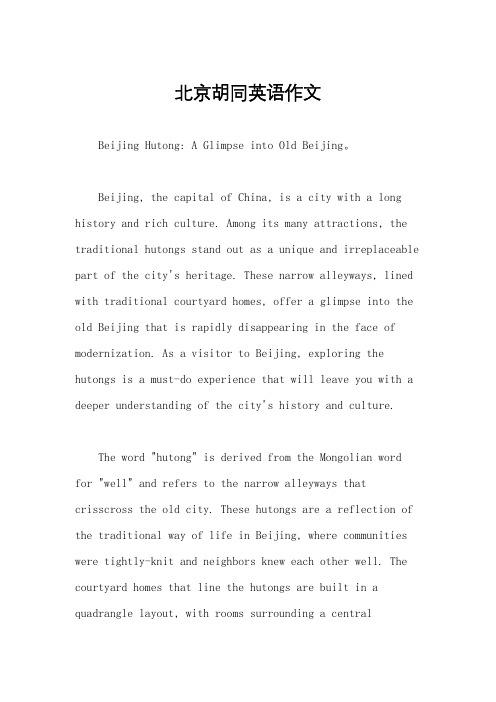
北京胡同英语作文Beijing Hutong: A Glimpse into Old Beijing。
Beijing, the capital of China, is a city with a long history and rich culture. Among its many attractions, the traditional hutongs stand out as a unique and irreplaceable part of the city's heritage. These narrow alleyways, lined with traditional courtyard homes, offer a glimpse into the old Beijing that is rapidly disappearing in the face of modernization. As a visitor to Beijing, exploring the hutongs is a must-do experience that will leave you with a deeper understanding of the city's history and culture.The word "hutong" is derived from the Mongolian wordfor "well" and refers to the narrow alleyways that crisscross the old city. These hutongs are a reflection of the traditional way of life in Beijing, where communities were tightly-knit and neighbors knew each other well. The courtyard homes that line the hutongs are built in a quadrangle layout, with rooms surrounding a centralcourtyard. This design was not only practical for thecity's climate, but also fostered a sense of community and privacy within the home.Walking through the hutongs, you will encounter a vibrant mix of old and new. On one hand, you will see traditional homes that have been passed down through generations, with intricate wooden carvings and delicate lattice windows. On the other hand, you will find trendy boutiques, cozy cafes, and art galleries that have sprung up in recent years, breathing new life into the old alleyways. This juxtaposition of old and new creates a dynamic and ever-changing atmosphere that is unique to the hutongs.One of the best ways to explore the hutongs is by taking a rickshaw ride. Riding in a traditional pedicab, you can leisurely wind your way through the narrow alleyways, taking in the sights and sounds of old Beijing. Your guide, often a local resident, will regale you with stories of the hutongs and their inhabitants, offering a personal and intimate perspective on life in the old city.You may even have the opportunity to visit a local family and experience firsthand the warmth and hospitality of the hutong community.In addition to the residential homes, the hutongs are also home to a variety of hidden gems, such as traditional Beijing-style siheyuan (quadrangle courtyard) residences, ancient temples, and local markets. These attractions offer a glimpse into the daily life of the residents and provide insight into the city's history and culture. For example,the Drum and Bell Towers, located in the heart of the hutongs, were once used to mark the time and regulate the city's daily activities. Today, they stand as a reminder of Beijing's rich history and are popular tourist destinations.As Beijing continues to modernize, the hutongs face the threat of demolition and redevelopment. Many of thesehistoric alleyways have already been lost, and those that remain are at risk of disappearing. To preserve this important part of Beijing's cultural heritage, efforts have been made to protect and restore the hutongs. The government has implemented policies to conserve thetraditional architecture and promote sustainable development in the area, while local residents have organized community initiatives to raise awareness and support for the preservation of the hutongs.In conclusion, the hutongs of Beijing offer a fascinating glimpse into the city's past and present. Their narrow alleyways, traditional courtyard homes, and vibrant mix of old and new create a unique and dynamic atmosphere that is not to be missed. By exploring the hutongs,visitors can gain a deeper understanding of Beijing's history and culture, and contribute to the preservation of this important part of the city's heritage. As the old saying goes, "To know Beijing, you must know the hutongs." So, if you find yourself in Beijing, be sure to take the time to wander through the ancient alleyways and experience the charm and history of the hutongs.。
有关写北京胡同的英语作文
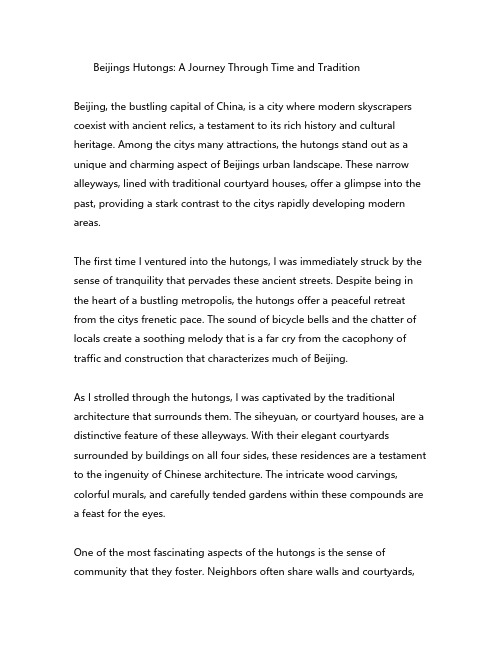
Beijings Hutongs:A Journey Through Time and TraditionBeijing,the bustling capital of China,is a city where modern skyscrapers coexist with ancient relics,a testament to its rich history and cultural heritage.Among the citys many attractions,the hutongs stand out as a unique and charming aspect of Beijings urban landscape.These narrow alleyways,lined with traditional courtyard houses,offer a glimpse into the past,providing a stark contrast to the citys rapidly developing modern areas.The first time I ventured into the hutongs,I was immediately struck by the sense of tranquility that pervades these ancient streets.Despite being in the heart of a bustling metropolis,the hutongs offer a peaceful retreat from the citys frenetic pace.The sound of bicycle bells and the chatter of locals create a soothing melody that is a far cry from the cacophony of traffic and construction that characterizes much of Beijing.As I strolled through the hutongs,I was captivated by the traditional architecture that surrounds them.The siheyuan,or courtyard houses,are a distinctive feature of these alleyways.With their elegant courtyards surrounded by buildings on all four sides,these residences are a testament to the ingenuity of Chinese architecture.The intricate wood carvings, colorful murals,and carefully tended gardens within these compounds are a feast for the eyes.One of the most fascinating aspects of the hutongs is the sense of community that they foster.Neighbors often share walls and courtyards,creating a closeknit environment where everyone knows each other.This sense of community is evident in the numerous small shops,teahouses, and restaurants that line the hutongs.These establishments are not just places to eat and drink they are social hubs where locals gather to chat, play games,and enjoy each others company.During my visit,I had the opportunity to sample some of the delicious local cuisine at a small restaurant tucked away in one of the hutongs.The dishes,which included Peking duck and jiaozi dumplings,were not only delicious but also a testament to the rich culinary traditions of Beijing.The restaurant was filled with locals and tourists alike,all enjoying the food and the convivial atmosphere.The hutongs are also a treasure trove of history and culture.Many of the alleyways are named after the trades and crafts that were once practiced there,such as Niu Jie Ox Street and Zhu Ba Jie Pearl Market Street. Walking through these streets,one can almost imagine the bustling activity of the past,with craftsmen and traders going about their daily business.However,the hutongs are not just a relic of the past they are also a living, breathing part of Beijings present.Efforts have been made to preserve and revitalize these historic areas,with many of the courtyard houses being converted into boutique hotels,art galleries,and cultural centers.This has helped to ensure that the hutongs remain a vibrant part of the citys cultural landscape.Despite these efforts,the future of the hutongs is not without its challenges.Rapid urban development and the pressures of modernization have led to the demolition of many of these historic areas.However,there is a growing awareness of the importance of preserving these cultural treasures,and many people are working tirelessly to ensure that the hutongs continue to be a part of Beijings identity.In conclusion,the hutongs of Beijing are a unique and invaluable part of the citys cultural heritage.They offer a window into the past,a glimpse of a way of life that is rapidly disappearing in the face of modernization.As I left the hutongs,I felt a deep sense of appreciation for the rich history and vibrant community that they represent.The hutongs are not just a part of Beijings past they are a living,breathing testament to the citys enduring spirit and cultural diversity.。
北京胡同英语210字作文
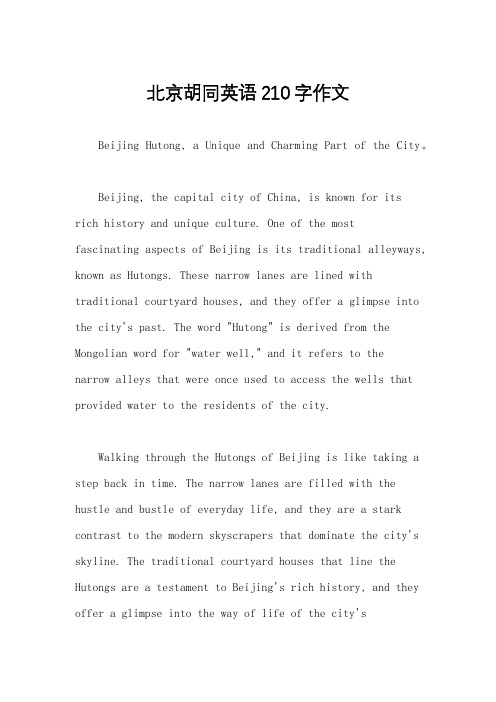
北京胡同英语210字作文Beijing Hutong, a Unique and Charming Part of the City。
Beijing, the capital city of China, is known for itsrich history and unique culture. One of the mostfascinating aspects of Beijing is its traditional alleyways, known as Hutongs. These narrow lanes are lined with traditional courtyard houses, and they offer a glimpse into the city's past. The word "Hutong" is derived from the Mongolian word for "water well," and it refers to thenarrow alleys that were once used to access the wells that provided water to the residents of the city.Walking through the Hutongs of Beijing is like taking a step back in time. The narrow lanes are filled with the hustle and bustle of everyday life, and they are a stark contrast to the modern skyscrapers that dominate the city's skyline. The traditional courtyard houses that line the Hutongs are a testament to Beijing's rich history, and they offer a glimpse into the way of life of the city'sresidents in centuries past.In addition to their historical significance, the Hutongs of Beijing are also home to a vibrant community. The residents of the Hutongs are known for their friendliness and hospitality, and they are always eager to share their stories with visitors. Many of the Hutongs are also home to small businesses, including traditional tea houses, restaurants, and shops that sell handmade crafts and souvenirs.Exploring the Hutongs of Beijing is a must-do for anyone visiting the city. Whether you're interested in history, architecture, or simply experiencing the authentic culture of Beijing, the Hutongs offer a unique and charming glimpse into the city's past. So, if you ever find yourself in Beijing, be sure to take a stroll through the Hutongs and immerse yourself in the rich history and culture ofthis fascinating city.。
北京胡同英语作文大学
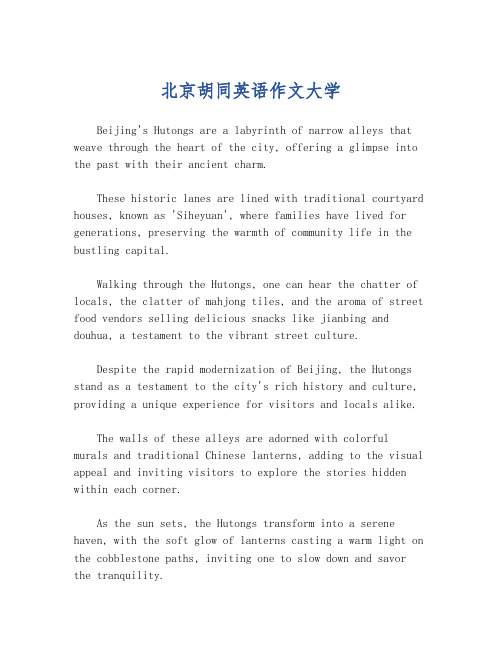
北京胡同英语作文大学Beijing's Hutongs are a labyrinth of narrow alleys that weave through the heart of the city, offering a glimpse into the past with their ancient charm.These historic lanes are lined with traditional courtyard houses, known as 'Siheyuan', where families have lived for generations, preserving the warmth of community life in the bustling capital.Walking through the Hutongs, one can hear the chatter of locals, the clatter of mahjong tiles, and the aroma of street food vendors selling delicious snacks like jianbing and douhua, a testament to the vibrant street culture.Despite the rapid modernization of Beijing, the Hutongs stand as a testament to the city's rich history and culture, providing a unique experience for visitors and locals alike.The walls of these alleys are adorned with colorful murals and traditional Chinese lanterns, adding to the visual appeal and inviting visitors to explore the stories hidden within each corner.As the sun sets, the Hutongs transform into a serene haven, with the soft glow of lanterns casting a warm light on the cobblestone paths, inviting one to slow down and savor the tranquility.Preserving these cultural gems is crucial, as they offera tangible connection to Beijing's past, allowing future generations to understand and appreciate the city's evolution.In conclusion, the Hutongs of Beijing are more than justa historical site; they are a living, breathing part of thecity's identity, a place where tradition and modernitycoexist in harmony.。
高中介绍北京胡同作文英文英语课文
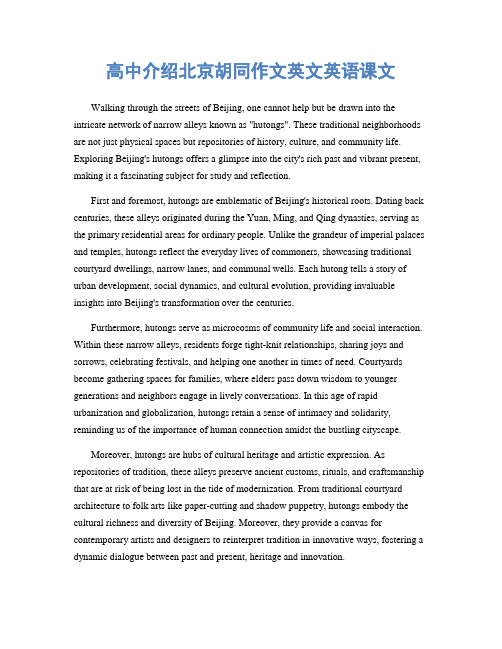
高中介绍北京胡同作文英文英语课文Walking through the streets of Beijing, one cannot help but be drawn into the intricate network of narrow alleys known as "hutongs". These traditional neighborhoods are not just physical spaces but repositories of history, culture, and community life. Exploring Beijing's hutongs offers a glimpse into the city's rich past and vibrant present, making it a fascinating subject for study and reflection.First and foremost, hutongs are emblematic of Beijing's historical roots. Dating back centuries, these alleys originated during the Yuan, Ming, and Qing dynasties, serving as the primary residential areas for ordinary people. Unlike the grandeur of imperial palaces and temples, hutongs reflect the everyday lives of commoners, showcasing traditional courtyard dwellings, narrow lanes, and communal wells. Each hutong tells a story of urban development, social dynamics, and cultural evolution, providing invaluable insights into Beijing's transformation over the centuries.Furthermore, hutongs serve as microcosms of community life and social interaction. Within these narrow alleys, residents forge tight-knit relationships, sharing joys and sorrows, celebrating festivals, and helping one another in times of need. Courtyards become gathering spaces for families, where elders pass down wisdom to younger generations and neighbors engage in lively conversations. In this age of rapid urbanization and globalization, hutongs retain a sense of intimacy and solidarity, reminding us of the importance of human connection amidst the bustling cityscape.Moreover, hutongs are hubs of cultural heritage and artistic expression. As repositories of tradition, these alleys preserve ancient customs, rituals, and craftsmanship that are at risk of being lost in the tide of modernization. From traditional courtyard architecture to folk arts like paper-cutting and shadow puppetry, hutongs embody the cultural richness and diversity of Beijing. Moreover, they provide a canvas for contemporary artists and designers to reinterpret tradition in innovative ways, fostering a dynamic dialogue between past and present, heritage and innovation.Additionally, hutongs offer a window into the challenges and opportunities of urban renewal and preservation. As Beijing undergoes rapid development and modernization, many hutongs face the threat of demolition and gentrification. However, there is growing recognition of the importance of preserving these historic neighborhoods as vital cultural assets and tourist attractions. Efforts are underway to renovate and revitalize hutongs, striking a balance between preserving their historical authenticity and meeting the needs of modern urban living. By studying the evolution of hutongs, we gain insights into the complexities of urban planning, heritage conservation, and sustainable development in contemporary China.In conclusion, Beijing's hutongs are not merely physical spaces but living testaments to the city's history, culture, and community life. By delving into their rich tapestry of stories and traditions, we gain a deeper understanding of Beijing's past and present, as well as the challenges and opportunities facing its future. As we navigate the labyrinthine alleys of hutongs, we embark on a journey of discovery, enlightenment, and appreciation for the enduring spirit of this ancient city.。
介绍北京胡同特色英语作文
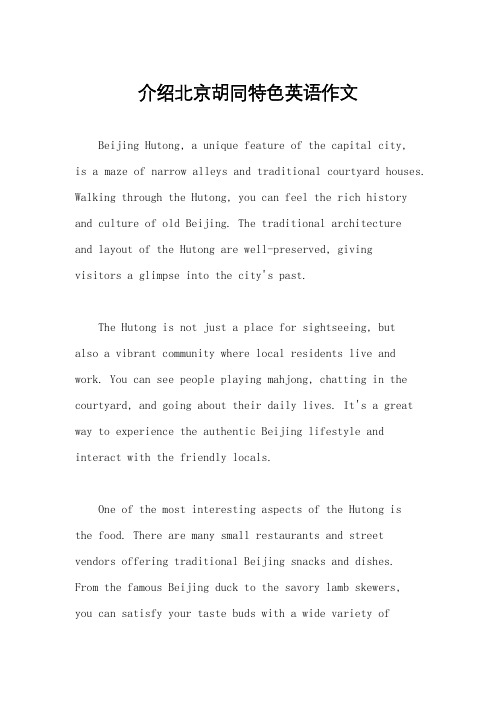
介绍北京胡同特色英语作文Beijing Hutong, a unique feature of the capital city,is a maze of narrow alleys and traditional courtyard houses. Walking through the Hutong, you can feel the rich history and culture of old Beijing. The traditional architectureand layout of the Hutong are well-preserved, givingvisitors a glimpse into the city's past.The Hutong is not just a place for sightseeing, butalso a vibrant community where local residents live and work. You can see people playing mahjong, chatting in the courtyard, and going about their daily lives. It's a great way to experience the authentic Beijing lifestyle and interact with the friendly locals.One of the most interesting aspects of the Hutong isthe food. There are many small restaurants and street vendors offering traditional Beijing snacks and dishes. From the famous Beijing duck to the savory lamb skewers,you can satisfy your taste buds with a wide variety ofdelicious foods.Exploring the Hutong on a rickshaw is a popularactivity for tourists. It's a fun and unique way tonavigate the narrow alleys and get a closer look at thelocal life. The rickshaw drivers are often very knowledgeable about the area and can provide interesting insights into the history and culture of the Hutong.In addition to the historical and cultural significance, the Hutong also plays a role in modern Beijing. Many Hutong have been renovated and transformed into trendy bars, cafes, and boutique shops. It's a perfect blend of old and new, where you can experience the traditional charm of the Hutong while enjoying modern amenities.Overall, the Beijing Hutong is a must-visit destination for anyone looking to experience the authentic culture and lifestyle of the capital city. Whether you're interested in history, food, or simply soaking up the local atmosphere, the Hutong has something to offer for everyone.。
用北京胡同写英语作文
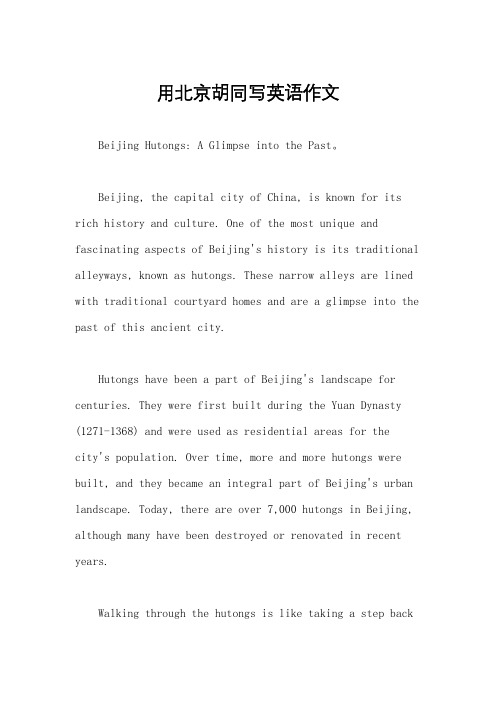
用北京胡同写英语作文Beijing Hutongs: A Glimpse into the Past。
Beijing, the capital city of China, is known for its rich history and culture. One of the most unique and fascinating aspects of Beijing's history is its traditional alleyways, known as hutongs. These narrow alleys are lined with traditional courtyard homes and are a glimpse into the past of this ancient city.Hutongs have been a part of Beijing's landscape for centuries. They were first built during the Yuan Dynasty (1271-1368) and were used as residential areas for thecity's population. Over time, more and more hutongs were built, and they became an integral part of Beijing's urban landscape. Today, there are over 7,000 hutongs in Beijing, although many have been destroyed or renovated in recent years.Walking through the hutongs is like taking a step backin time. The traditional courtyard homes, or siheyuan, are built around a central courtyard and are usually two or three stories tall. The homes are made of brick and wood and are decorated with intricate carvings and colorful tiles. The courtyards are often filled with plants and flowers, creating a peaceful and serene atmosphere.One of the most famous hutongs in Beijing is Nanluoguxiang. This alleyway is lined with shops, restaurants, and bars, and is a popular destination for both locals and tourists. The street is bustling with activity, and the traditional architecture and street food vendors give it a unique charm.Despite their historical significance, many hutongs are in danger of disappearing. In recent years, many hutongs have been demolished to make way for modern buildings and infrastructure. However, there has been a growing movement to preserve these unique alleyways and their cultural heritage. The government has designated some hutongs as protected areas, and there are now efforts to renovate and restore many of the old homes.Visiting the hutongs is a must-do experience for anyone visiting Beijing. It is a chance to see the city's rich history and culture up close and to get a glimpse into what life was like in ancient times. As Beijing continues to modernize and change, the hutongs remain a testament to the city's past and a reminder of the importance of preserving cultural heritage.。
2020高考英语作文范文:北京胡同
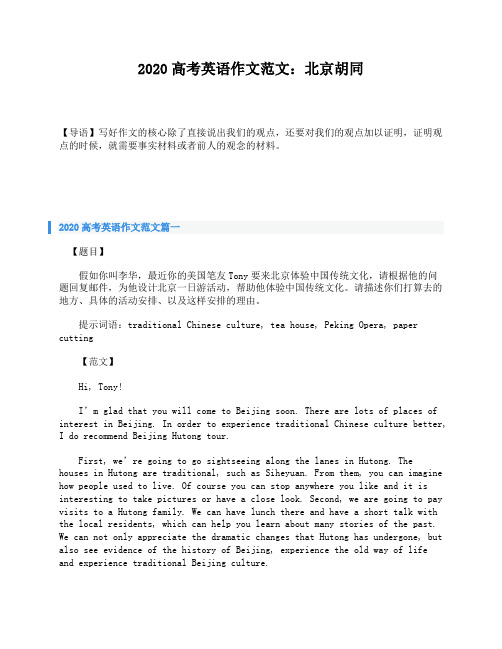
2020高考英语作文范文:北京胡同【导语】写好作文的核心除了直接说出我们的观点,还要对我们的观点加以证明,证明观点的时候,就需要事实材料或者前人的观念的材料。
2020高考英语作文范文篇一【题目】假如你叫李华,最近你的美国笔友Tony要来北京体验中国传统文化,请根据他的问题回复邮件,为他设计北京一日游活动,帮助他体验中国传统文化。
请描述你们打算去的地方、具体的活动安排、以及这样安排的理由。
提示词语:traditional Chinese culture, tea house, Peking Opera, paper cutting【范文】Hi, Tony!I’m glad that you will come to Beijing soon. There are lots of places of interest in Beijing. In order to experience traditional Chinese culture better, I do recommend Beijing Hutong tour.First, we’re goi ng to go sightseeing along the lanes in Hutong. The houses in Hutong are traditional, such as Siheyuan. From them, you can imagine how people used to live. Of course you can stop anywhere you like and it is interesting to take pictures or have a close look. Second, we are going to pay visits to a Hutong family. We can have lunch there and have a short talk with the local residents, which can help you learn about many stories of the past. We can not only appreciate the dramatic changes that Hutong has undergone, but also see evidence of the history of Beijing, experience the old way of lifeand experience traditional Beijing culture.In a word, Hutongs are the homes of common people in the past. It is easy to know how people lived and had fun in the old days. So it is a good choice to learn about traditional Chinese culture.I’m looking forward to your coming.延伸阅读:其他优秀范文两篇2020高考英语作文范文篇二保护中国传统文化【题目】某中学生英文报就“保护中国传统文化”为主题举行英语征文活动。
- 1、下载文档前请自行甄别文档内容的完整性,平台不提供额外的编辑、内容补充、找答案等附加服务。
- 2、"仅部分预览"的文档,不可在线预览部分如存在完整性等问题,可反馈申请退款(可完整预览的文档不适用该条件!)。
- 3、如文档侵犯您的权益,请联系客服反馈,我们会尽快为您处理(人工客服工作时间:9:00-18:30)。
2020高考英语作文范文:北京胡同
【导语】写好作文的核心除了直接说出我们的观点,还要对我们的观点加以证明,证明观点的时候,就需要事实材料或者前人的观念的材料。
2020高考英语作文范文篇一
【题目】
假如你叫李华,最近你的美国笔友Tony要来北京体验中国传统文化,请根据他的问
题回复邮件,为他设计北京一日游活动,帮助他体验中国传统文化。
请描述你们打算去的地方、具体的活动安排、以及这样安排的理由。
提示词语:traditional Chinese culture, tea house, Peking Opera, paper cutting
【范文】
Hi, Tony!
I’m glad that you will come to Beijing soon. There are lots of places of interest in Beijing. In order to experience traditional Chinese culture better, I do recommend Beijing Hutong tour.
First, we’re goi ng to go sightseeing along the lanes in Hutong. The houses in Hutong are traditional, such as Siheyuan. From them, you can imagine how people used to live. Of course you can stop anywhere you like and it is interesting to take pictures or have a close look. Second, we are going to pay visits to a Hutong family. We can have lunch there and have a short talk with the local residents, which can help you learn about many stories of the past. We can not only appreciate the dramatic changes that Hutong has undergone, but also see evidence of the history of Beijing, experience the old way of life
and experience traditional Beijing culture.
In a word, Hutongs are the homes of common people in the past. It is easy to know how people lived and had fun in the old days. So it is a good choice to learn about traditional Chinese culture.
I’m looking forward to your coming.
延伸阅读:其他优秀范文两篇
2020高考英语作文范文篇二
保护中国传统文化
【题目】
某中学生英文报就“保护中国传统文化”为主题举行英语征文活动。
你准备给该报投稿,稿件内容包括:
1. 保护中国传统文化的重要性
2. 列举1-2个你所知道的国家或当地政府文化保护的事例;
3. 谈谈你对文化保护的建议。
字数要求:120字。
【范文】
Protect Traditional Chinese Culture
The protection of national and folk culture is of GREat significance to Chinese cultural diversity and also to the harmonious development between local economic and social development. It is reported that the Guangdong government pays special attention to protecting Chaoju(潮剧), a local drama born in Chaozhou in the eastern Guangdong province.
In my opinion, some measures should be taken to protect traditional
culture effectively. To start with, we should make a law to regulate the society’s performance. Besides, we should draw more people’s attention to it, for the more they know about the importance of culture protection, the
stronger support we can get from the public.
In a word, it is high time for us to treasure and develop our own valuable culture.
2020高考英语作文范文篇三
京剧
【题目】
假定你是李华,你想邀请在中国留学的英国好友Peter观看京剧表演,但Peter不在家,你给他写张留言条,包括以下内容:
1. 你到Peter家的目的;
2. 介绍京剧;
3. 询问什么时候方便,再约时间观看。
注意:
1. 词数100左右;
2. 可以适当增加细节,以使行文连贯。
参考词汇:quintessence 精华,精粹;ornate 华丽的
【范文】
Dear Peter,
I came to see you but you were out. I’d like to invite you to see Beijing Opera with me next week, since you have always wanted to know more about Chinese culture since the first day to China.
With a history of nearly 200 years, Beijing Opera is a form of traditional Chinese theatre, which is considered as the quintessence of Chinese culture. The performers in ornate costume perform various stories that happened in history to audience by singing, dance and motions. I can tell you more about it when we meet.
Please let me know when you will be free and I will buy the tickets in advance. I sincerely hope that you can accept my invitation and I’m sure you’ll enjoy it.
Yours,
Li Hua。
